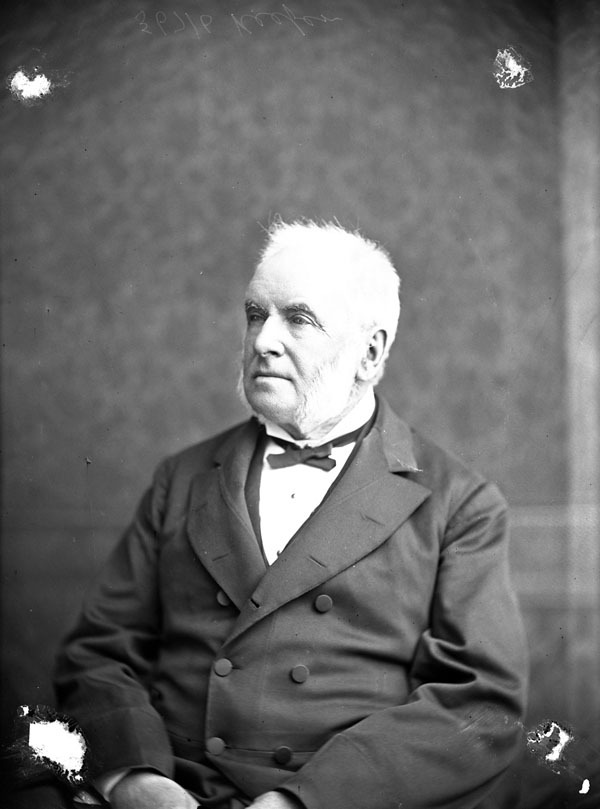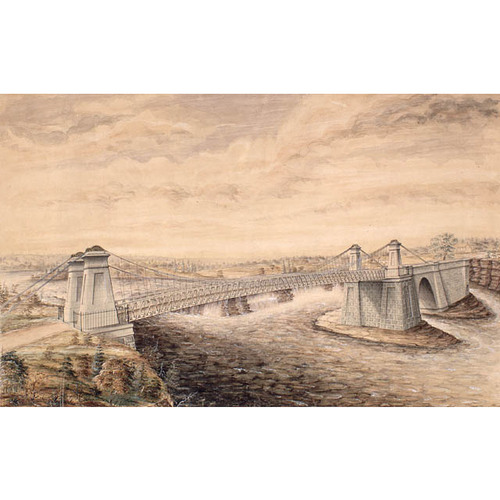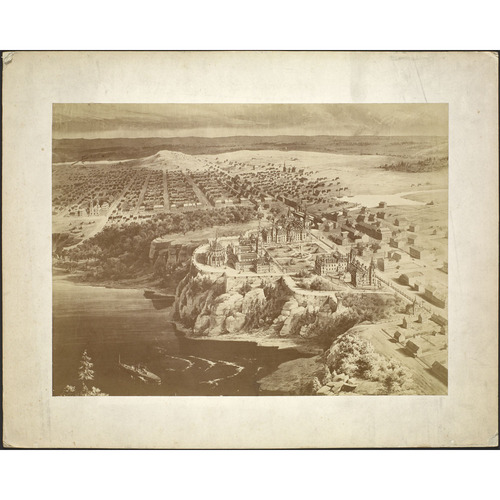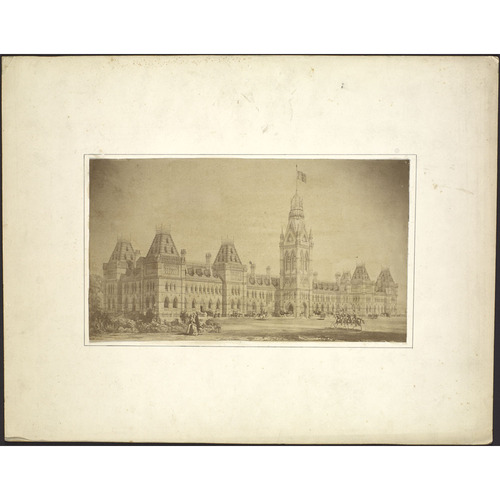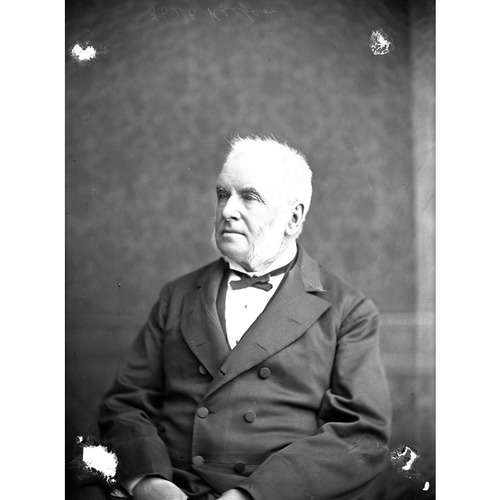KEEFER, SAMUEL, civil engineer and public servant; b. 22 Jan. 1811 at Thorold, Upper Canada, fourth son of George Keefer* and Catherine Lampman; m. first 13 May 1840 Anne E. Crawford (d. 1876), second daughter of Senator George Crawford*, of Brockville, Upper Canada; m. secondly in December 1883 Rosalie E. Pocock, also of Brockville; d. there 7 Jan. 1890.
Politics and engineering were necessarily related in mid-19th-century Canada since most big projects were public works in which the key jobs were political appointments. Samuel Keefer’s apprenticeship from 1827 to 1833 in the Welland Canal Company, which was interrupted by two years at Upper Canada College, was an ideal preparation for an engineering career in such a world. Under the guidance of his father, who was president of the company, William Hamilton Merritt*, its driving force, and the Erie Canal veterans who engineered the work, Keefer learned the technical and political lessons of his craft. Expertise and political influence eventually carried Samuel Keefer to the top of his chosen profession, from which he fell in disgrace, only to be rescued by grateful political friends.
In 1833, after the completion of the Welland Canal, Keefer managed to secure an appointment as secretary to a commission established by the government of Lower Canada to recommend ways of improving navigation on the St Lawrence River near Montreal. When the House of Assembly ignored the commission’s report it became apparent that no work would result from it and Keefer returned to Upper Canada in 1834 as an assistant engineer on the Cornwall Canal. This much interrupted project remained unfinished when the money ran out in 1838 and Keefer and the rest of the staff were dismissed. Nevertheless, Keefer recovered from this setback. A year later, no doubt with some help from his friends, he was appointed secretary to the newly established Board of Works of Lower Canada and with the reorganization of the board following the union of 1841 he became its chief engineer. By the age of 30 Keefer held one of the most important engineering appointments in British North America.
The Board of Works (after 1846 the Department of Public Works) was the largest department in the provincial bureaucracy. In 1842 its headquarters staff of four administered a field staff of 92, which included many engineers. A decade later the field staff numbered over 200 and by confederation had reached 500. The board built and maintained many of the roads and bridges of the province (although these were being turned over to local authorities wherever possible); it also looked after the timber slides, harbours, and lighthouses, and it was responsible for housing the peripatetic provincial government and its departments. But in the 1840s by far its greatest and most costly responsibility was the completion of the St Lawrence canal system. In the 1850s oversight of the planning and construction of the provincial railway system would be added to these responsibilities.
Hamilton Hartley Killaly*, a boisterous Irish eccentric, ruled over this vast transportation empire, and a proud and sober Samuel Keefer served as his second in command and chief rival. Each hired and trained his own “school” of engineering protégés, and naturally the professional jealousy at the top of the department permeated the struggle for place and preferment that went on below. In the early 1840s at least, there was enough work for everyone. During his tenure as chief engineer Samuel Keefer laid out the Beauharnois Canal, directed the enlargement of the Lachine Canal, rebuilt the lock at Sainte-Anne-de-Bellevue and the canal at Saint-Ours on the Richelieu River, and carried out preliminary surveys for a canal at Sault Ste Marie. He designed the suspension bridge over the Chaudière Falls at Bytown (Ottawa), completed in 1844, and introduced economical solid-timber gates on the St Lawrence locks in 1850. From 1846 to 1848 he was placed in direct charge of enlarging and re-aligning the Welland Canal.
Keefer also managed to negotiate the difficult transition from one transportation technology to another. When the railway era arrived in earnest he left the Department of Public Works in 1853 to take up more lucrative employment as a divisional engineer on the Grand Trunk Railway under Alexander McKenzie Ross. There he acquired the knowledge and experience that laid the groundwork for the second half of his career. He supervised construction of the line between Montreal and Kingston (which he had previously surveyed for the government), including two important bridges at Sainte-Anne-de-Bellevue and Kingston Mills. He also decided upon the location of the great Victoria Bridge at Montreal, preliminary work for which had been done by his half-brother, Thomas Coltrin Keefer*. When the railway opened for business, in 1856, he served briefly as superintendent of its eastern division while simultaneously acting as chief engineer for the projected Brockville and Ottawa Railway.
He was called back into public service by the government of John A. Macdonald* and Étienne-Paschal Taché*. In the aftermath of the horrible Desjardins Canal wreck of 12 March 1857, which claimed 60 lives, including that of Samuel Zimmerman*, the assembly had passed an Act for the Better Protection of Accidents on Railways which required regular inspection of the road-bed, cuttings, embankments, bridges, rolling-stock, engines, and operating procedures of every railway in the province. Samuel Keefer was appointed as the first inspector of railroads. His surviving letterbooks attest to his stern attention to detail and the seriousness with which he conducted himself as protector of the public safety. But the correspondence also shows the practical difficulty of enforcing proper procedures and imposing expensive improvements upon financially shaky railway companies. Safety regulation became, in practice, a trade-off between pliant and accommodating politicians and earnest but powerless officials, all too frequently punctuated with disaster.
When in 1859 Hamilton Killaly’s career as deputy of the largest spending department of government had to be sacrificed to the universal demand for retrenchment and restraint, Samuel Keefer had the duties of deputy commissioner of public works added to his responsibilities as inspector of railroads on 6 May. The most immediate task facing the new deputy was the design and construction of permanent parliament and departmental buildings at Ottawa. He devised an elaborate scheme to determine the best design submitted in the architectural competition and his recommendation of the plan of Thomas Fuller* and Chilion Jones for the centre block and the designs of Frederick Warburton Stent and Augustus Laver for the flanking buildings met with general approval. However, with the choice of Thomas McGreevy* as principal contractor and in the supervision of his work, Keefer began the trial of his life. With construction already in progress, designs had to be altered to provide for heating and ventilation among other things. Expenditures vastly exceeded estimates. Communications broke down completely between the commissioner of the department until 1861, John Rose, and his deputy amidst mutual frustration and embarrassment. Hamilton Killaly was called back to pass judgement upon the work of his successor. Finally, with a change of government and governors general, a royal commission was appointed by the government of John Sandfield Macdonald* and Louis-Victor Sicotte to investigate what had become the Parliament Buildings scandal.
In 1863 the royal commission reported that the Department of Public Works had not examined the site properly before calling for tenders. Instead of being a level site, as the architects and contractors had assumed, it was a hill of solid rock. More shocking still, the commissioners discovered that McGreevy’s successful bid had been drawn up by departmental officials from the schedules submitted with the competing tenders. Notwithstanding this collusion, when the contractors and the government could not agree upon what was to be done under the tendered rates and what was to be charged as more expensive “extra” work, Keefer appeared to have consistently given McGreevy the benefit of the doubt. As deputy commissioner, Keefer naturally bore the brunt of these charges which he took without accusing his equally culpable political superiors. His competence in question and his character besmirched, Samuel Keefer retired to private practice in 1864.
He returned to the Niagara district to begin the reconstruction of his career. There he built the second suspension bridge across the gorge which, when it was opened to traffic in 1869, was the longest bridge of its kind in the world. For this achievement he ultimately won a gold medal in the engineering competition at the 1878 universal exposition in Paris. Alas, the bridge blew down in the great storm of 1889 after the bridge company directors had doubled its width without consulting their engineer.
Keefer’s political friends never forgot his ordeal and sacrifice, and in gratitude sought to redeem his reputation. “I have long been waiting my opportunity to reconnect you in some way with the Public Service,” Sir John A. Macdonald wrote in November 1870, “and now I think the time has come.” Macdonald appointed Keefer secretary to the canal commission, chaired by Hugh Allan, in the hope, he said, that some work might rebound to him from its report. Keefer did conduct some surveys for the stillborn Baie Verte canal in 1872, but during the dark days of Liberal rule he was reduced to building bridges for the city of Ottawa. His main achievement for the city was the construction of the Dufferin Bridge across the Rideau Canal at Confederation Square. After the Conservatives returned to power, Keefer also returned, in 1880, as one of three royal commissioners appointed to investigate the conduct of the Alexander Mackenzie* administration in Canadian Pacific Railway affairs. Now that the former victim had become judge, it might be said that his vindication was complete.
Keefer spent his remaining years in semi-retirement in Brockville where he was active in the Church of England and in local Conservative political affairs. He also took a hand in attempting to elevate engineering above immediate political and commercial servitude to proper professional status. Since 1860 he had been a member of the Institute of Civil Engineers in London and in 1869 joined the American Society of Civil Engineers. In 1887 Keefer helped found the Canadian Society of Civil Engineers, serving as its second president (T. C. Keefer was the first). A lifelong Conservative, Samuel Keefer obviously suffered for his partisanship, but because of it he survived.
AO, MU 2664–776. PAC, MG 24, E1; I106; MG 26, A; MG 29, A2; D61; RG 11, A1, 1–39; B1, 828–43; RG 43, ser. B4b, 91, 93–94. Can., Canadian Pacific Railway Royal Commission, Report (3v., Ottawa, 1882); Parl., Sessional papers, 1871, VI: no.54. Can., Prov. of, Parl., Sessional papers, 1862, II: no.3; February–May 1863, II: no.3. Canadian Soc. of Civil Engineers, Trans. (Montreal), 1 (1887)–4 (1890). Daylight through the mountain: letters and labours of civil engineers Walter and Francis Shanly, ed. F. N. Walker (Montreal, 1957). Lower Canada, House of Assembly, Journals, 1834: app.E. Cyclopædia of Canadian biog. (Rose, 1886). H. G. J. Aitken, The Welland Canal Company: a study in Canadian enterprise (Cambridge, Mass., 1954). Canada and its prov. (Shortt and Doughty), X: 475–624. D. [G.] Creighton, The empire of the St. Lawrence (Toronto, 1956). Currie, Grand Trunk Railway. J. P. Heisler, The canals of Canada (Ottawa, 1973). Hodgetts, Pioneer public service. Robert Keefer, Memoirs of the Keefer family (Norwood, Ont., 1935). T. C. Keefer, The old Welland Canal and the man who made it (Ottawa, 1911); Philosophy of railroads and other essays, ed. H. V. Nelles (Toronto and Buffalo, N.Y., 1972). R. A. J. Phillips, The east block of the Parliament Buildings of Canada: some notes about the building, and about the men who shaped Canada’s history within it (Ottawa, 1967). A. H. Armstrong, “Profile of parliament hill,” Royal Architectural Institute of Can., Journal (Toronto), 34 (1957): 327–31. C. C. J. Bond, “The Canadian government comes to Ottawa, 1865–66,” OH, 55 (1963): 23–34.
Cite This Article
H. V. Nelles, “KEEFER, SAMUEL,” in Dictionary of Canadian Biography, vol. 11, University of Toronto/Université Laval, 2003–, accessed March 31, 2025, https://www.biographi.ca/en/bio/keefer_samuel_11E.html.
The citation above shows the format for footnotes and endnotes according to the Chicago manual of style (16th edition). Information to be used in other citation formats:
| Permalink: | https://www.biographi.ca/en/bio/keefer_samuel_11E.html |
| Author of Article: | H. V. Nelles |
| Title of Article: | KEEFER, SAMUEL |
| Publication Name: | Dictionary of Canadian Biography, vol. 11 |
| Publisher: | University of Toronto/Université Laval |
| Year of revision: | 1982 |
| Access Date: | March 31, 2025 |


